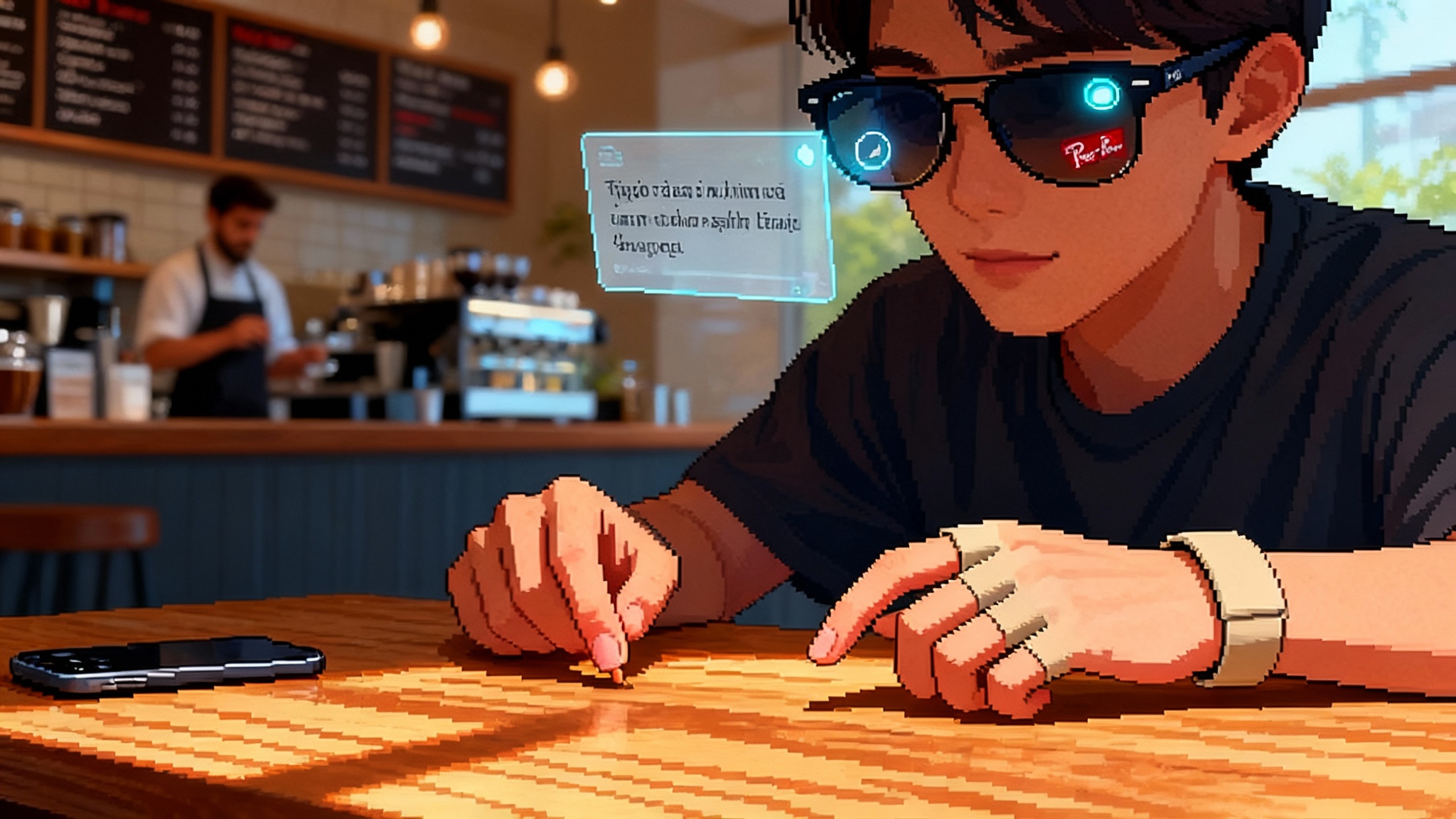First-Person AI Arrives: Your Field of View Is the App
Meta's new Ray-Ban Display and a wrist EMG band push first-person computing into everyday life. See how perceptual agents reshape attention, memory, consent, and why quiet timing will beat chat in the next interface.

Breaking the fourth wall of computing
On September 30, 2025, Meta began selling Ray-Ban Display, a consumer pair of smart glasses with an integrated screen, bundled with a new wrist-worn controller called the Meta Neural Band. The band reads electromyography signals in your forearm to detect tiny finger movements. Together with on-glasses live translation and an on-device assistant, the package turns your field of view into software. Meta framed it plainly: glasses you can look through that also respond to what you see and what you intend to do, all at a mass-market price, as outlined in Ray-Ban Display launch details.
For a decade we mostly talked to artificial intelligence in chat windows. Now AI looks out at the world with us. That shift is larger than it seems. When the interface follows your gaze, your hands, your pace, and your surroundings, the computer is no longer a place you go. It becomes an overlay that meets you where attention already lives.
From chat to perception
Conversation was the training wheels phase of modern AI. It taught us that a model could be a partner in reasoning and drafting. But conversation is slow and brittle. You must describe context with words the system does not share, then wait while it tries to reconstruct the scene you are already in.
Perception collapses that gap. The glasses see what you see, hear what you hear, and borrow your motion as a clock. The Neural Band captures a private channel of intent. Instead of building mental pictures from text, the model anchors on your actual environment and actions. That makes its suggestions sharper and its timing less annoying. It also unlocks a class of use cases that chat was never designed for: moment-to-moment guidance, just-in-time memory, and anticipatory help.
If you want to see the foundations of this approach, look at research into egocentric learning. Large first-person datasets taught models to understand hands, tools, and attention from the wearer’s perspective. The scale and task design in the egocentric benchmark known as Ego4D showed how to make past visual experience queryable and how to track objects and actions across time, as documented by the Ego4D benchmark tasks.
What first-person context actually unlocks
Think of your day as a movie the system can sample. A first-person agent can:
- Recognize tasks by place and posture. If you are standing at a stove, it can surface the next step of a recipe in your periphery. If you are walking toward a subway entrance at 8:12 a.m., it can pull up your pre-saved route and show a subtle platform arrow without asking.
- Track objects across time. When you ask, Where did I leave the blue notebook, the system can scroll your recent visual history and mark the moment you set it down on the dining chair.
- Extract checklists from observed work. After three bike-repair sessions, the model has enough examples to offer a short checklist when you pull out the hex wrench again.
- Bridge languages on the fly. Live translation can run on the glasses and companion app. Ask for a bakery recommendation and carry on a two-language conversation while you both see or hear translations.
None of this requires new human superpowers. It stitches together cues you already give off. The stitching depends on models trained to attend to hands, tools, and places from the point of view that matters most: yours.
Silent intent: the wrist signal that replaces wake words
Wake words are clumsy in shared spaces. They leak your intent to everyone nearby and to every microphone in range. Electromyography, which senses muscle activity that precedes motion, flips that script. The Neural Band detects tiny finger gestures and translates them into commands. You can execute a click, a scroll, a volume tweak, or a yes with a gesture so small it looks like a thought.
This yields a viable input trio for everyday life:
- Eyes for context and selection
- Voice for complex requests and dictation when appropriate
- EMG for silent confirmation, quick edits, and mode switches
Imagine a quiet museum. You glance at a placard, the glasses recognize the piece, and a small card slides into the corner of your view. You pinch once to expand for more context or twice to save the note to a trip journal. No wake word and no phone in hand. Now picture a grocery store. You look at a shelf, the system recognizes the product, and a subtle dot appears. A micro-swipe on the band flips the view to unit price comparisons. These are tiny motions, but they change the social ergonomics from performing with a device to deciding with one.
Ambient prompts: help that starts itself
Chat required you to form a thought and type it. Perceptual agents invert that. They offer a small, unintrusive prompt when the situation is clear, then wait for your silent yes. The trick is restraint. Think of the assistant as a good stage manager. It sets the props, marks the exits, and whispers only when needed.
- In your kitchen the model notices a pot beginning to boil and surfaces a two-minute timer chip. You ignore it and it slides away.
- While driving the agent highlights a lane merge ahead and offers a route change. You approve with a tap on the wheel button mapped to the band. It confirms once through audio.
- At work the system recognizes you have joined the weekly stand-up and automatically pins the three updates you typed earlier into your peripheral view when your name is called.
We already see early versions of this in notification summaries and calendar nudges. What is new is precision timing based on what you are physically doing and seeing.
Why perceptual agents will outcompete chatbots
Perceptual agents have three structural advantages over chat-only systems:
-
Lower prompt tax. They do not need you to explain the scene. Video, audio, and location provide the missing nouns and verbs.
-
Higher timing accuracy. Because they see your task boundary transitions, they can suggest the next action at the right moment. In human work, timing often beats eloquence.
-
Better learning loops. First-person streams capture completion, not just intention. The system sees the before and after of a task. That makes reinforcement and retrieval more data efficient than scraping text that rarely shows final outcomes.
Taken together, these advantages yield a distinct product edge. Over time, the best assistants will be the ones that are present and quiet, not the ones that are most talkative.
To see how incentives will shape these systems, pair this shift with policy and governance. We have argued that the real levers live in what we called the invisible policy stack. A first-person agent that wins trust will combine excellent timing with transparent settings that ordinary people can understand and control.
What changes in us: attention, memory, consent
-
Attention. Human attention is elastic but fragile. A perceptual agent can reduce context switches by keeping micro-instructions in the periphery. Done well, that sustains focus. Done poorly, it injects drip notifications into the very space your eyes use to concentrate. The design rule is simple: if the user has not signaled intent, prompts should be small and slow to appear, with a one-gesture dismissal that teaches the system to back off.
-
Memory. Our experience is episodic and messy. First-person logs make past time searchable. That is a gift for people with memory challenges and for anyone who wants a personal trail of decisions. It is also a risk. A personal memory that never forgets will capture other people who did not consent to be remembered. Default retention should be short. Long-term memories should be opt-in, event-scoped, and visibly bookmarked in the moment, not decided later by a buried setting.
-
Consent. When the interface is your gaze, other people become part of your interface without asking. That calls for new social signals. Today we have a small recording light. We will need more: a visible on-display icon that mirrors the exact data state, a quick flip that blanks the camera in sensitive spaces, and a way to request deletion if you were captured. Consent should be treated as a reversible permission, not a one-time checkbox. For a deeper dive on consent culture in AI, see our analysis of consent after Anthropic's pivot.
Near-term norms we should adopt
We do not need legislation to begin practicing better etiquette. Homes, offices, and schools can adopt norms now:
- The glance rule. If someone makes eye contact and asks, Are you recording, you either show the status indicator in the display or take the glasses off. No debate.
- Wrist-off zones. In classrooms, courtrooms, and clinics, remove the Neural Band at the door. A visible absence of input goes a long way to earn trust.
- Mirror mode on request. Anyone can ask you to flip the display into mirrored mode for a second so they can see what the system is showing. If it surfaces information about them, they should know.
- Consent tokens for shared spaces. Offices can place a small near-field tag at room entrances. When you enter, your glasses flip to privacy mode unless the tag says recording is allowed for that room and time.
- Tap to forget. A universal gesture to delete the last 30 seconds for everyone in frame. Show an animated confirmation so bystanders know it happened.
These habits will not solve every conflict, but they create visible rituals that keep human comfort in the loop.
Design guardrails for builders
If you are shipping for first-person computing in the next year, design with these constraints:
- On-device first. Perception and intent signals should run locally by default. Only explicit user actions should leave the device, and they should do so with the smallest possible payload.
- Memory is a product surface. Offer three modes: an ephemeral buffer that rolls off after hours, a session memory that ends when you leave a place or finish a task, and pinned memories that the user bookmarks and names. Treat each as a literal folder the user can see and manage.
- Time as an index. Let users scrub their day by time and place. A good user interface shows 9:20 a.m. Kitchen. Boiled pasta. Timer set. Colander used. That is what people will search for.
- Predictable prompts. All proactive cards should follow the same shape, entry animation, and location so they are easy to ignore or accept. Novelty is the enemy of habit here.
- EMG as a second factor. Because the Neural Band is tied to muscle patterns, use it to confirm sensitive actions. A small, user-chosen two-gesture pattern can act like a password for money moves or message sends.
- Developer testing in public. Dogfood in real-world scenes with non-employees present. Publish your mitigation playbook for misfires before launch, not after.
Where competitors now stand
Every major platform vendor understands that perception will define the next interface. Apple pushed visual computing into the mainstream with a high-end headset and is iterating along that path. Google’s Glass project failed a decade ago, but Android’s hardware ecosystem is moving back toward head-worn displays. Snap pioneered camera glasses for creators and offers lessons on youth adoption. Humane’s chest pin showed that a device without first-person video struggles to ground help in the world around you. The gap is not whether to build for the eyes and hands. It is how fast developers learn the new ergonomics and how well each platform earns social permission to live in the line of sight.
Strategically, this is a battle of ecosystems and models. Platforms that welcome diverse model lineups will adapt faster as tasks differentiate. We explored why pluralism compounds in model pluralism wins the platform war. The same logic applies at the edge: the best glasses will route requests across local and cloud agents based on latency, privacy, and cost.
Practical playbooks for the next 90 days
-
For product teams. Pick one real-world workflow with repetitive steps and a clear finish state: replacing a bicycle chain, setting up a home router, or inspecting a rental car. Capture 100 sessions, annotate the sequences, and train an assistant that does exactly one thing: time the next-step card to the moment the hands and tools enter frame. Measure completion time and error rate. Ship when you cut both by at least 20 percent.
-
For operations leaders. Pilot a consent-forward environment. Put wrist-off tags at sensitive doors. Move all recording to short-buffer mode on the floor, with opt-in for exception cases. Train managers on how to honor Tap to forget in front of customers. Publish the policy visibly so people see the rules before they see the glasses.
-
For educators. Use the display for stepwise practice, not for answers. In labs and studios the assistant should surface method cards and safety prompts. Save answer keys and solution hints for voice-only requests so students must ask intentionally.
-
For families. Make a home policy the same way you made a smartphone policy years ago. Where the glasses live, when they are allowed at dinner, which guests prefer wrist-off. Write it down. Children learn the rules by watching adults follow them.
-
For regulators. Focus on retention, deletion, and duty to explain. Mandate short defaults, require a human-scaled playback of what was captured, and make it easy for a bystander to request erasure by tapping their phone to the wearer’s band. Do not write rules that assume a phone camera. The vector is different now.
What could go wrong and how to reduce the blast radius
-
Perpetual noticing. An eager assistant can become a mosquito. Throttle proactive prompts based on refusal streaks. If you dismiss three recipe cards in a row, the system should stop offering them until you explicitly ask next time.
-
Proxy privacy leaks. The model might surface information about a person near you. Default this off in public and require explicit opt-in by both parties in private. In product terms, the person being described should see an on-display notice and approve via a simple gesture.
-
Shadow work. If the assistant starts tasks for you, it can also create obligations you did not intend, like sending a follow-up note you would have preferred to forget. Make every auto-start action reversible for a short window and log it in a visible queue so you can cancel with a two-gesture pattern.
-
Overreliance. It is tempting to let the system remember instead of you. Bake friction into pinning memories. A memory that matters deserves a name and a tag the moment you save it. The small cost helps prevent an undifferentiated archive you never visit.
-
Social strain. Wearables change rooms. Give bystanders influence over your interface. A quick mirror mode, a visible indicator, and wrist-off zones are not only good manners. They are system requirements for public trust.
Implementation notes for builders and buyers
- Latency budget. Sub-100-millisecond response time is the difference between a fluid micro-gesture and a stutter that breaks flow. Cache likely actions locally and pre-render prompt shells that can be filled without visible delay.
- Battery reality. Field-of-view computing lives or dies on energy. Dim the display by default, pause inference on head movement that suggests you are not looking, and allow scheduled sampling rates that slow the sensor stack when the wearer is idle.
- Error handling. Misrecognitions are inevitable. The remedy is a graceful no. Offer a tiny, standard card shape with a one-word label and a cancel gesture that doubles as feedback. The next model update should learn from that refusal streak.
The field-of-view era
Interfaces shape thought. Mouse and window made documents and files feel real. Touch made every surface a potential button. First-person AI makes attention itself the canvas. That is a responsibility as much as a feature. If we get the ergonomics and the norms right, perceptual agents will be the quietest computers we have used and the most helpful ones. They will work because they are present and polite, not because they are loud.
The shift from chat to perception will not wait for perfect hardware. It is already here in small ways: a wrist flick to translate a menu, a glance to retrieve a step, a pinch to save a moment in a place you will remember. The rest will be choices about consent, memory, and timing. The companies that respect those choices will win. The rest will be noisy.
This time the interface is not a screen in your hand. It is your sightline. Treat it with care and it will treat your attention with care in return.








